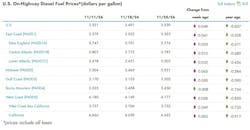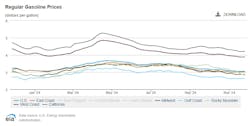Diesel prices jump up for the holidays, gas hovers above $3
The week of Thanksgiving, the U.S. Energy Information Administration recorded a bump in diesel fuel prices, with the national average jumping 5 cents from last week to $3.539 per gallon. While this price is still 60 cents cheaper than this time last year, diesel costs rose across most of the country.
The one exception was the Rocky Mountain region, where diesel prices dropped for the fourth straight week, if only by less than a cent, to $3.450. Otherwise, diesel fuel prices increased from less than a cent to 6 cents, depending on the region.
In California, prices were relatively stable, rising less than a cent to $4.662. However, the West Coast region saw its average diesel prices rise 2 cents to $4.177, and the East Coast’s diesel prices jumped by 4 cents to $3.593. On the higher end, the West Coast without California’s diesel costs rose almost 5 cents to $3.755, and the Gulf Coast’s diesel prices rose 5 cents to $3.203 per gallon. The Midwest was hit hardest by the price increase, with diesel costs at the pump jumping 6 cents to $3.531.
The Gulf Coast is still the cheapest place for diesel fuel at $3.202 per gallon, while California is the most expensive at $4.662.
For once, the AAA motor club’s numbers differed very little from the EIA’s. AAA’s current diesel average is $3.530 per gallon, not quite a cent more than the EIA’s numbers, and only less than a cent cheaper than last week’s diesel prices of $3.534. According to the motor club, this week’s average is 71 cents cheaper than this time last year, when diesel prices were at $4.242.
See also: Diesel continues to slide under $3.50/gal, gas under $3.05/gal
Gasoline prices more varied than diesel
While diesel prices increased uniformly across the board, the EIA found that gas price movements were more erratic. The national average gas price decreased by less than a cent to $3.044 per gallon (but this price point is still 19 cents less than this time last year), and the Midwest region’s gas prices dipped by 1 cent to $2.866. But the Rocky Mountain region’s gas prices fell once again this week by almost 9 cents to $2.828.
Meanwhile, the rest of the country’s gas prices inched up, but only by less than a cent along the East Coast, Gulf Coast, West Coast, and in California. The East Coast’s gas prices currently sit at $3.011 per gallon, the Gulf Coast is at $2.635, the West Coast’s gas costs $3.884, and California’s costs $4.202. The West Coast without California saw their gas prices rise by 1 cent to $3.538 per gallon, but no other region’s prices rose or fell at a higher rate. This leaves the Gulf Coast as the cheapest place for gas for now (as the Rocky Mountain region’s gas prices continue to fall), while California remains the most expensive.
The AAA’s national gas price average is $3.056 per gallon, a little over a cent more expensive than the EIA’s. The motor club’s gas prices fell 2 cents from last week’s average of $3.071 and 20 cents from prices this time last year ($3.259).
About the Author
Alex Keenan
Alex Keenan has been associate editor for Endeavor's Commercial Vehicle Group, which includes FleetOwner magazine, since 2022. She has written on a variety of topics for the past several years and recently joined the transportation industry, reviewing content covering technician challenges and breaking industry news. She holds a bachelor's degree in English from Colorado State University in Fort Collins, Colorado.


